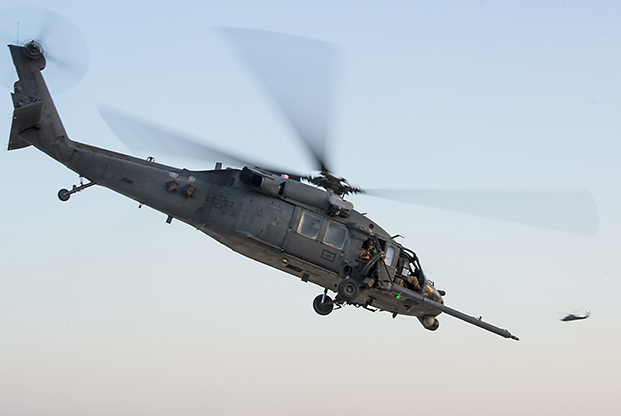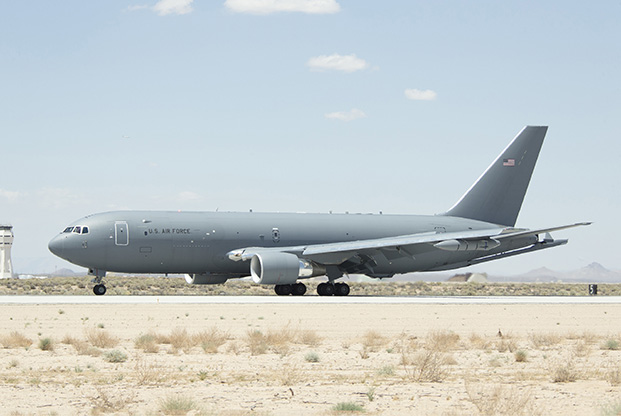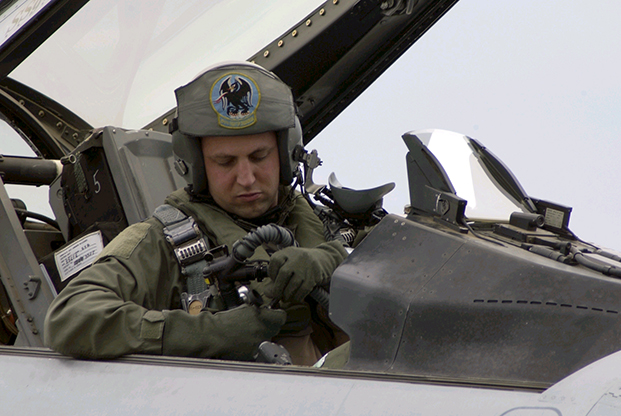
An HH-60 Pave Hawk crew trains to provide personnel recovery operations and support. A USAF Pave Hawk operating in Ukraine catastrophically crashed after the pilot misinterpreted navigation displays. Photo: SSgt. Keither James
HELO STRUCK CABLE, CAUSING FATAL MARCH CRASH IN IRAQ
The HH-60G Pave Hawk that crashed in March, killing all seven on board, struck a galvanized steel cable, bringing it down onto the Iraqi desert, the Air Force announced.
The HH-60G, assigned to the 332nd Air Expeditionary Wing, was flying alongside another Pave Hawk during the night of March 15. The helicopter crews were tasked with prepositioning at a base that would bring them closer to an upcoming operation.
During the flight, the Pave Hawk overflew its intended destination because the aircraft’s pilot misinterpreted aircraft navigation displays, according to an Air Combat Command Accident Investigation Board report recently released. As a result, the helicopter descended into an unplanned location and turned to avoid a tower, but struck an unseen 3/8-inch diameter galvanized steel cable that was strung horizontally between two 341-foot high towers.
The cable entangled itself in the HH-60G’s main rotor assembly, resulting in “catastrophic damage and an unflyable condition.” The aircraft was traveling so fast, the impact was not survivable and debris scattered a large area of the desert, according to the report.
The other Pave Hawk saw the light of the crash and circled back, calling for a quick-reaction force of pararescuemen in another HH-60G to secure the site.
The crash killed four airmen from the New York Air National Guard’s 106th Rescue Wing: Capt. Christopher Zanetis, 37, an HH-60G pilot from Long Island City, N.Y.; Capt. Andreas O’Keeffe, 37, a Pave Hawk pilot from Center Moriches, N.Y.; MSgt. Christopher Raguso, 39, a resident of Commack, N.Y., an HH-60G special missions aviation flight engineer; and SSgt. Dashan Briggs, 30, a resident of Port Jefferson Station, N.Y., also an HH-60G special missions aviation flight engineer. Two of the airmen killed were Air Force Reserve pararescuemen from the 308th Rescue Squadron at Patrick AFB, Fla. They are MSgt. William Posch, 36, and SSgt. Carl Enis, 31. Also killed was Capt. Mark Weber, a combat rescue officer with the 38th Rescue Squadron at Moody AFB, Ga.
The helicopter, tail No. 92-6466, was completely destroyed at a loss of $49 million.

Whither Pegasus? Boeing still plans on delivering aircraft by the end of this year. Photo: Christopher Okula/USAF
NO KC-46 DELIVERY IN OCTOBER
The Air Force did not receive its first KC-46 in October as originally expected, while the program office and Boeing are still working to address five “category one” deficiencies that still need to be remedied, Gen. Maryanne Miller, the head of Air Mobility Command, said Oct. 26. The original deadline of 0ctober has passed, but Boeing said it still plans to deliver the aircraft by the end of the year.
SHANAHAN: SPACE FORCE DETAILS COMING SOON
The Defense Department must submit its plan to Congress in December detailing what it thinks the new Space Force should look like and how much it will cost to create the service, said Deputy Defense Secretary Patrick Shanahan. He acknowledged the Air Force’s estimate that it will cost $13 billion to establish the new service over the next five years, but he urged reporters to “put that number aside” and wait until details of the Fiscal 2020 budget are released. When asked what the new service will look like, how the personnel will be transitioned, and whether there will be a Space Guard, for example, Shanahan said, “I don’t know.”
AETC FIRES THREE COMMANDERS AT LAUGHLIN
Three commanders at a main flying training wing were fired after investigations into chronic leadership failures, Air Education and Training Command announced on Oct. 30.
Col. Charles Velino, commander of the 47th Flying Training Wing at Laughlin AFB, Texas, along with the operations group commander and a flying training squadron commander at the base were relieved by Air Education and Training Commander Lt. Gen. Steven Kwast after a review and recommendation from the commander of 19th Air Force, according to an AETC press release.
Col. Lee Gentile, formerly the commander of the 71st Flying Training Wing at Vance AFB, Okla., has assumed command of the wing.
“The prior command team chronically failed to appropriately care for people and the mission,” Kwast said in the release. “They failed to correct an evolving situation that led to an environment where some airmen did not feel safe or respected.”
AETC did not detail the specific actions, but stated that the commanders did not take appropriate steps to respond to, correct, and report incidents of officer misconduct. Some reports allege the incidents include a female pilot being given a vulgar name during a drinking ritual and another case involving a threat.
The command change comes as the Air Force’s flying training wings face repeated incidents of hypoxia-related events and crashes involving T-6 and T-38 aircraft, including a November crash of a Talon from Laughlin that killed one pilot and injured another.
USAF AIRLIFT PLAN CALLS FOR INCREASE IN C-17S, REDUCTION IN C-130S
Air Mobility Command is still trying to figure out exactly how it will increase the number of its C-17 squadrons while simultaneously looking to reduce the size of its C-130 fleet. The Air Force at AFA’s Air, Space & Cyber Conference in September outlined its plan to grow the number of total squadrons to 386, which included a large increase for Air Mobility Command airlift and aerial refueling squadrons.
The “Air Force We Need” calls for more airlift, but only with C-17s. Specifically, the Air Force wants an increase of three C-17 squadrons, with a corresponding drop of two C-130J squadrons. USAF studies have shown the strategic airlifter is in higher demand for potential future conflicts than the tactical C-130, AMC boss Gen. Maryanne Miller told reporters previously. The plan is largely based on classified information, so the Air Force’s reasoning for why it would need the larger C-17 isn’t public. However, Air Mobility Command is finalizing a mobility capabilities study for its future needs, which is in coordination with the Pentagon and Congress and will be released in the near future.
The Air Force cannot, right now, say how any potential jump in the C-17 fleet would be possible because the Boeing production line for C-17s has closed.
Those details “we have not looked at,” and would be the focus of future discussions with Congress. The “Air Force We Need” plan is an “initial stage” to get the concept out there, and more in-depth discussions are forthcoming, Miller said.

Then-Capt. Seth Nehring in the cockpit of an F-16. Photo: SMSgt. Chris Drudge
CALIFORNIA GUARDSMAN KILLED IN SU-27 CRASH
Lt. Col. Seth “Jethro” Nehring, 44, of Fresno, Calif., died Oct. 16 in an Su-27 crash during the Clear Sky 2018 exercise in Ukraine.
Nehring, a California Air National Guardsman, was assigned to the 194th Fighter Squadron, 144th Fighter Wing. He was deployed to Ukraine in support of the Clear Sky 2018 exercise, and he was riding in a single-aircraft familiarization flight with a Ukrainian pilot when the aircraft crashed at about 5 p.m. local time in the Khmelnytski region of Ukraine, according to statements from US Air Forces in Europe and the California governor’s office.
“This is a sad day for the United States and Ukraine,” said Maj. Gen. Clay Garrison, California National Guard commander and Clear Sky 2018 exercise director, in a news release. “Our deepest condolences go out to the family, friends and fellow airmen of both the US airman and Ukrainian aviator who were killed in the incident.”
The exercise is a large multinational exercise involving about 950 personnel from nine countries, according to USAFE. It also marks the 25th anniversary of the partnership between the California National Guard and Ukraine. Both US and Ukrainian governments are investigating the crash.
Military Intelligence Gets Big Boost With Return to Great Power Competition
The Defense Department is spending billions more on classified intelligence programs, with the most recent numbers representing the biggest spike in years. In Fiscal 2018, Congress appropriated $22.1 billion for military intelligence—that’s a $3.7 billion increase from Fiscal 2017 appropriated funds and $1.4 billion more than what was originally requested in Fiscal 2018. The ramp-up in classified funding comes amid a return to “great power competition,” as outlined in the most recent National Security Strategy. Chief of Staff Gen. Joseph F. Dunford told military reporters last week that, “Our competitive advantage has eroded over time, and that needs to be dealt with.”
THE WAR ON TERRORISM
Casualties:
As of Oct. 29., a total of 56 Americans had died in Operation Freedom’s Sentinel in Afghanistan, and 69 Americans had died in Operation Inherent Resolve in Iraq and Syria.
The total includes 121 troops and four Department of Defense civilians. Of these deaths, 53 were killed in action with the enemy while 72 died in noncombat incidents.
There have been 346 troops wounded in action during OFS and 75 troops in OIR.